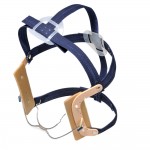
The prevalence of palatally displaced permanent canine teeth varies between 0.8 and 5.2 % . The aim of this trial was to test the effectiveness of cervical pull headgear and rapid maxillary expansion and cervical pull headgear on the eruption of palatally displaced canines.
They randomized 64 patients with to one of three groups: cervical pull headgear (HG); rapid maxillary expansion and cervical pull headgear (RME/HG); or untreated control group (CG). Panoramic radiographs and lateral cephalograms were evaluated at baseline (T1) and at an average period of 18 months (T2). The success of canine eruption was evaluated at T2. A superimposition study on lateral cephalograms was undertaken to evaluate the T1–T2 changes in the sagittal position of the upper molars in the three groups.
They found that the prevalence of successful eruption was greater in both the RME/HG and HG groups.
[table id=6 /]
The cephalometric superimposition study showed a significant mesial movement of the upper first molars in the Control group compared with the HG and RME/HG groups.
They concluded:-
The use of rapid maxillary expansion and headgear (or headgear alone) in palatally displaced canines cases increases the success rate of eruption of the canine significantly.
Armi P, Cozza P, Baccetti T. Effect of RME and headgear treatment on the eruption of palatally displaced canines: a randomized clinical study. Angle Orthod. 2011 May;81(3):370-4. Epub 2011 Feb 7. PubMed PMID: 21299387.
